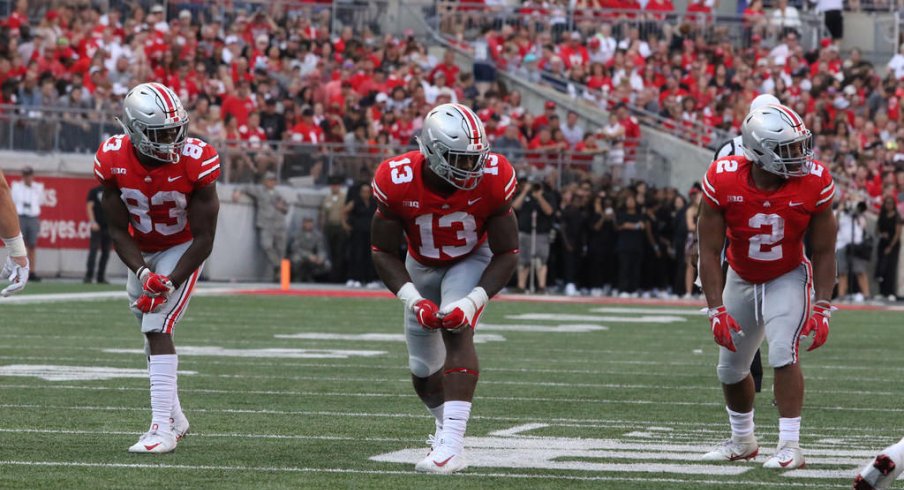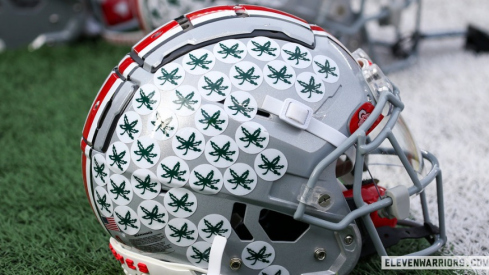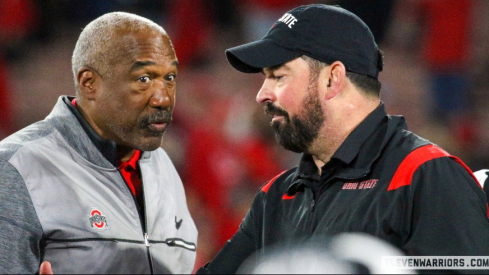Throughout the final games of the 2018 Ohio State football season, Ryan Day received praise from all corners of the football world. After dismantling former colleague Don Brown's vaunted Michigan defense in the regular season finale, the former NFL quarterback coach had many analysts fawning over the design of an Ohio State for the first time in years.
Surely, former Buckeye units had drawn praise for the effective methods of bludgeoning inferior talent, with attacks primarily designed around the running game. But in only Day's second year on campus, and with perhaps the most talented passer in school history, last fall's Scarlet and Gray attack proved to be one of the nation's best in an era where high-powered spread offenses have become the norm.
While Day's former boss and predecessor as head coach in Columbus, Urban Meyer, was famous for spreading out defenses with three or four receivers stretched from sideline to sideline, one of Day's most effective tactics as leader of the OSU offense was to compress those bodies in a tighter space. Contrary to conventional thinking, this didn't mean trading speedy wideouts for bigger bodied fullbacks and tight ends, but rather, by bunching the same personnel that was used to spread the field in tight next to the offensive line.
For those that follow the pro game closely, this tactic should sound familiar, as it mirrors the plan utilized by Sean McVay and the L.A. Rams en route to a Super Bowl appearance. In a league built upon exploiting an opponent's tendencies, the Rams led the NFC in yards and points despite keeping the same 11 personnel group (1 back, 1 tight end) on the field an astounding 90% of the time. By moving the back, tight end, and receivers in and out of bunch sets from play-to-play, defenses were forced to keep the same personnel on the field to defend very different looks.
As those defenses have evolved over the past decade to better neutralize the one-on-one mismatches created outside the hash marks that spread looks are meant to create, shrinking the field uses many of a defense's best tactics against itself. While top defenses have come to rely on man-coverage as a means of stopping run/pass options, the easiest way to sew confusion in a secondary is to align receivers in a bunch set before they break out in every direction, often creating rubs between defenders like a pick on the basketball court.
This was the underlying philosophy behind the Mesh series that shredded the Wolverines back in November. Not only were Wolverine defenders trying to get out of their own way, but Day was able to isolate individual receivers against the defender of his choosing, creating the best matchup possible.
But compressing receiver splits before the snap isn't just a tactic for freeing them at the line, it's a useful method to create room in the running game, especially on the edges. With defenses often lining up with five defensive backs (or more) as a base look on first and second down, lining up two or three extra bodies next to a tackle forces those DBs to now defend a run gap.
While every defender on the field should be able to step up and tackle a ball-carrier, the addition of simple motions from these looks forces the entire defense to communicate new responsibilities in ways that are difficult to replicate in practice. Additionally, perimeter receivers often don't block the man in front of them, creating advantageous angles by cracking back inside.
The condensed alignment of all 11 players is reminiscent of systems like the Wing-T, which used angle blocking and crafty ball-handling to trick defenders into looking the wrong way. According to long-time University of Delaware head coach Tubby Raymond, the man who essentially perfected the system, the quickest way to get a runner to the edge is by shortening it.
The use of motions and fake handoffs allowed the Buckeyes to leave defenders entirely unblocked, betting they wouldn't be able to find the ball and make plays in time.
As seen above with the Mesh series, these compressed formations can make life difficult in the passing game, as defenses often have just one automatic check for such looks. If the offense knows that that check will be (as was seemingly the case in the Michigan game), then they can easily manipulate the defense to take advantage.
Not only might an offense know which coverage to expect against a bunch look (or cluster, as Ohio State calls it), but they know which players will be particularly stressed in the coverage. For instance, if the defense is going to check to a traditional Cover-3 zone, then the secondary has to not only gain depth in their drops but often width as well, shuffling at an angle instead of back-peddling and making them uncomfortable.
Instead of reading the play in front of them, these defenders often focus on simply getting to their designated spot, leaving open seams all around them.
Given the threat of the aforementioned running game, play-action is especially effective from condensed formations. Instead of looking to create one-on-one matchups, like in spread looks, these shorter splits allow receivers to easily come across the field and overload zone coverage despite lining up in a balanced, 2x2 look (sometimes called a vice set when the perimeter receivers cut their split down to line up inside).
The picture provided by compressed and bunch alignments is distorted for a defense used to seeing their opponents lined up from sideline to sideline, creating a false sense of security. But just because receivers may start the play inside the hashes doesn't mean they'll finish there.
Concepts like Scatter (also known as Spacing or All-Curl), which overload the four underneath zone defenders with five receivers, are designed strictly to create width across the field while providing a quick and easy read for the quarterback.
If defenses over-compensate to gain width in their coverage, then vertical seams often come wide open in response.
To recap, mixing in bunch and compressed formations can provide a number of benefits:
- Provides very different looks without substituting personnel
- Quicker to get runners on the edge
- More blockers at the point of attack and more gaps to defend in the run game
- Creates natural rubs and picks against man-coverage
- Forces defense to declare their intentions early
- Distorts pass coverage responsibility by adding a horizontal element to vertical zone drops
Just like any schematic tactic, though, these alignments are most effective when used in moderation and mixed in with more traditional spread formations. Unlike the Rams, whose tendencies were eventually exposed on the biggest of stages, the Buckeyes are not known for leaning on these looks primarily.
But as Day breaks in another first-year starting QB this fall, wrinkles like these will make life much easier for the newly-eligible Justin Fields.



